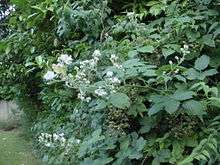Bramble



In British English, a "bramble" is any rough (usually wild) tangled prickly shrub—specifically the blackberry bush (Rubus fruticosus)—or any hybrid of similar appearance, with thorny stems. Bramble or brambleberry may also refer to the blackberry fruit or products of its fruit (e.g., bramble jelly).[1] The shrub grows abundantly in all parts of the British Isles and harvesting the fruits in late summer and autumn is often considered a favourite pastime. It can also become a nuisance in gardens, sending down its strong suckering roots amongst hedges and shrubs. Many consider it a weed due its tendency to grow in neglected areas and its sharp, tough thorns which can be hazardous to children and pets.[2]
Elsewhere, such as in the United States, the term "bramble" also refers to other members of the Rubus genus, which may or may not have prickly stems—notably the raspberry (Rubus idaeus) or its hybrids.
Etymology
"Bramble" comes from Germanic bram-bezi, whence come also German Brombeere, Dutch Braambes and French framboise. It originated before the year 1000; Middle English; Old English bræmbel, variant of brǣmel, equivalent to brǣm- (cognate with Dutch braam broom ).[3]
Description
Bramble bushes have long, thorny, arching shoots and root easily.[4] They send up long, arching canes that do not flower or set fruit until the second year of growth. Brambles usually have trifoliate or palmately-compound leaves.
Bramble fruits are aggregate fruits.[5] Each small unit is called a drupelet. In some, such as the blackberry, the flower receptacle is elongated and part of the ripe fruit, making the blackberry an aggregate-accessory fruit.
Uses
Many species are grown and bred for their fruit. Ornamental species can be grown for flowers (e.g. Rubus trilobus), for their ornamental stems (e.g. Rubus cockburnianus) and some as ground cover (e.g. Rubus tricolor). Members of the Rubus genus tend to have a brittle, porous core and an oily residue along the stalk which makes them ideal to burn, even in damp climates. The thorny varieties are sometimes grown for game cover and occasionally for protection.
Most species are important for their conservation and wildlife value in their native range. The flowers attract nectar-feeding butterflies and hoverflies, and are a particular favourite of Volucella pellucens.
Brambles are important food plants for the larvae of several species of Lepidoptera—see list of Lepidoptera that feed on Rubus. The leaves of brambles are often used as a main food source for captive stick insects. Many birds, such as the common blackbird, and some mammals will feed on the nutritious fruits in autumn.
Split bramble stems are traditionally used as binding material for straw in production of lip-work basketry, such as lip-work chairs and bee skeps and sometimes used to protect other fruits such as strawberries.
Bramble leaves can be used to feed most Phasmatodea. Young leaves contain a toxin that can be harmful to many species of Phasmatodea, however this only occurs up until their third instar, by which time they have developed an immunity to it.
Cultivation

There are many different systems developed for the commercial culture of blackberries and raspberries. Bramble cultivars are separated into several categories based on their growth habit. They are categorized as erect, semi-erect, or trailing.
See also
References
| Wikimedia Commons has media related to Rubus. |
- ↑ Shorter Oxford English dictionary, 6th ed. United Kingdom: Oxford University Press. 2007. p. 3804. ISBN 0199206872.
- ↑ https://www.rhs.org.uk/advice/profile?PID=256
- ↑ "the definition of bramble". Dictionary.com. Retrieved 2016-02-15.
- ↑ "Brambles and other woody weeds /RHS Gardening". www.rhs.org.uk. Retrieved 2016-02-15.
- ↑ "Bramble or blackberry | Woodlands.co.uk". www.woodlands.co.uk. Retrieved 2016-02-15.